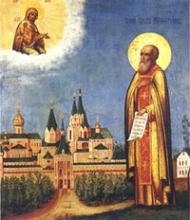3/16 December
 Venerable Savva, abbot of Storozhev, Miracle-worker of Zvenigorod, was quite young when he came to the Monastery of Venerable St. Sergius of Radonezh (+ 1392, commemorated 5 July and 25 September) and was tonsured a monk. He was one of the earliest disciples of and fellow-strugglers with St. Sergius. Under that teacher’s direction, St. Savva learned obedience, humility, keeping one’s thoughts to himself, abstinence, and chastity. The Saint loved silence, and therefore avoided meeting other people. He was never idle, and often wept over the poor state of his soul. The Saint ate only fruits and vegetables, wore coarse clothing, and slept on the floor. St. Savva’s ascetic way of life won him everyone’s love; he was made a presbyter, and St. Sergius appointed him spiritual director of the monastics. St. Savva’s instructions were so edifying, that not only the monks, but also lay people would open their souls to him.
Venerable Savva, abbot of Storozhev, Miracle-worker of Zvenigorod, was quite young when he came to the Monastery of Venerable St. Sergius of Radonezh (+ 1392, commemorated 5 July and 25 September) and was tonsured a monk. He was one of the earliest disciples of and fellow-strugglers with St. Sergius. Under that teacher’s direction, St. Savva learned obedience, humility, keeping one’s thoughts to himself, abstinence, and chastity. The Saint loved silence, and therefore avoided meeting other people. He was never idle, and often wept over the poor state of his soul. The Saint ate only fruits and vegetables, wore coarse clothing, and slept on the floor. St. Savva’s ascetic way of life won him everyone’s love; he was made a presbyter, and St. Sergius appointed him spiritual director of the monastics. St. Savva’s instructions were so edifying, that not only the monks, but also lay people would open their souls to him.
With the blessing of St. Sergius, Monk Savva became abbot of the Monastery of the Dormition of the Mother of God, established on the banks of the Dubyonka River by Great Prince Dimitry Donskoy of Moscow in thanks for his victory over Mamai. In 1392, when Igumen Nikon, St. Sergius’ successor, retired as monastery administrator and withdrew to his cell, the brotherhood of the Holy Trinity Monastery persuaded Ven. St. Savva to return to their monastery and take up the Abbot’s staff. For six years St. Savva, often turning in prayer for help from Ven. St. Sergius, was a pastor to the flock entrusted into his care. While Abbot of the Monastery, and following the example set for him by St. Sergius, St. Savva brought forth by his prayers a spring beyond the Northern wall of the Monastery.
Prince Yuriy Dimitrievitch of Zvenigorod, a godson of St. Sergius, chose St. Savva to be his spiritual director. At his request, St. Savva established a new monastery near Zvenigorod. However, striving after solitude, St. Savva departed for a deserted place, the Storozhev Hill. There he erected a wooden church dedicated to the Nativity of the Most-holy Theotokos and a small cell for himself. Rumors about his monastic spiritual struggles attracted to him many others in search of solitude and a silent, contemplative way of life. In 1399, the Saint established a monastery on the Storozhev Hill and with paternal love accepted into it all those seeking salvation; he instructed them in monastic obedience and humility. Despite his advanced age, St. Savva struggled a great deal to establish the monastery. He performed all of the essential tasks, setting an example for the monks, and warning everyone against idleness. About a kilometer’s distance from the monastery, he dug himself a cave in which he would dedicate himself to long periods of tearful prayer and meditation upon God.
I
t pleased the Lord to reward the Saint: For his extremely virtuous life he was granted the gift of clairvoyance. Before Prince Yuriy Dimitrievitch set off on a military campaign, the Saint prayed, then blessed him, and prophesied his victory and safe return.
The Saint reposed at a very advanced age on December 3, 1406. In the chronicle of 1539, Venerable Savva is referred to as a Miracle-worker. In the mid-16th Century, an account of those miracles was set down. Before his relics, the sick received healing, and demons were cast out of those who were possessed. On several occasions, Venerable St. Savva, abbot of Storozhev appeared to the residents of the monastery who had turned to him in prayer.
On one occasions, St. Savva appeared to the iconographer Dionissy, Abbot of the Monastery. Following that apparition, Abbot Dionissy wrote the first Icon of St. Savva.
His incorrupt relics were found on January 19, 1652.
